Are you dreaming of launching your own fragrances and cosmetics business, but feel overwhelmed by the complexity and the sheer number of options? Imagine a clear, step-by-step roadmap that guides you with a straightforward business mindset and disciplined execution, transforming your idea from a concept on paper into a successful storefront or an online channel that drives sales and repeat business with confidence. This is where the value of partnering with a reliable perfume and home fragrance manufacturer, such as Jasmine, truly shines.
In this article, you will find everything you need to get started: why this sector is profitable, how to prepare a concise and realistic feasibility study for your cosmetics project, an analysis of the startup costs and how to break down its components, a practical projection of the potential profits for a cosmetics store, the best methods for selling makeup and fragrances online, proven operational and marketing tips, and why Jasmine is a smart choice for manufacturing and bottling, complete with answers to the most frequently asked questions on this topic.
Why is cosmetics business One of the most profitable?
The beauty market simply never stops growing. While consumer tastes may shift and evolve, the consistency of daily personal care remains a constant, making a cosmetics and fragrance business one of the most stable and long-term profitable ventures.
Independent estimates suggest that the size of the global makeup market was valued at approximately $296 billion in 2023, with a projected Compound Annual Growth Rate (CAGR) of nearly 6% through 2030. This steady growth trajectory explains why the sector is viewed as an attractive commercial safe haven, even when other retail segments face volatility.
When fragrances are added to the equation, the opportunity expands further. The global perfume market was valued at around $56.6 billion in 2024, with growth expectations nearing 4.9% annually until 2030. Integrating a varied, multi-tiered price range of perfumes within your store significantly increases the average transaction value and encourages repeat purchases, shifting the consumer experience from buying a single product to adopting a complete routine (skincare + makeup + fragrance).
Furthermore, the rise of digital channels adds a significant layer of profitability. Recent studies show that online beauty sales are growing much faster than brick-and-mortar stores. Industry reports for 2025 note robust digital growth exceeding in-store sales growth, which means an online cosmetics business can unlock additional revenue with limited operational costs, provided it is managed smartly.
Even the performance indicators of major specialty retailers reinforce this positive outlook. Business reports in 2025 observed strong growth for beauty manufacturers and retailers, highlighting fragrances as the category driving the highest growth for some major chains, a strong sign of robust actual, not merely theoretical, demand.
As for our regional markets, the trend is equally positive. Recent regional estimates anticipate that the beauty and personal care market in the Middle East and North Africa (MENA) is set to reach tens of billions by 2030, driven by accelerating growth led by younger demographics and preferences for “clean products” and “Halal” cosmetics. This makes a cosmetics business feasibility study in the region particularly realistic, especially for entrepreneurs who successfully balance a reliable international assortment with touches tailored to local preferences.
How Profitable and sustained-demend is cosmetics?
The profitability in makeup stems from a simple formula: fast-moving consumer goods (FMCG) that are habitually repurchased. Daily essentials like lipstick, mascara, foundation, and other routine care products drive consistent profits for a cosmetics store because they build a repeat-purchase habit, not just a one-off transaction. With global forecasts projecting the beauty market to grow by around 5–6% annually until 2030, a makeup business remains one of the ventures that directly benefits from this fundamental, cyclical consumption.
In the same vein, the beauty e-commerce is no longer an appendix to the physical store; it has become a parallel growth engine. Reports for 2025 indicate that online beauty spending is accelerating faster than traditional channels, supported by social media content and quick discovery experiences. Therefore, designing a streamlined customer journey via WhatsApp or an online store enables a cosmetics e-commerce business to convert interest into daily sales, with a manageable cost of customer acquisition through focused offers and samples.
How to Convert These Facts into Business Value?
- Focus on Fast-Moving Top SKUs instead of a scattered product range.
- Dedicate a Try & Choose corner with authentic samples to build long-term trust.
- Link every purchase to an offer for an add-on mini perfume or a gift bag/kit.
- Activate a WhatsApp channel for quick orders and dedicated after-sales service.
Contact the Jasmine team to request an initial opening inventory list of suitable fragrances for your city and budget, get an estimate of your cosmetics project cost and profit margins, and review options for essential oils and private-label bottling.
Also read: How to Start a Wholesale Perfume Business & Is It Profitable?
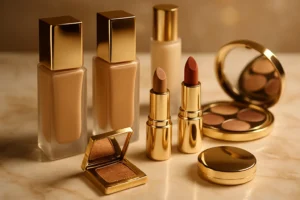
Feasibility Study on Cosmetics Business
The feasibility study presented here is more than just a sheet of numbers; it’s a practical business plan for a cosmetics and fragrance venture that transforms the idea into a store that drives sales and repeat business.
In the following lines, you will find a coherent overview covering the market, the operational model, the product list, costs, projected profits, and break-even points, while integrating online options from day one.
1) Target Customers
- Customer Segments: University students, working professionals, brides-to-be, and gift shoppers for special occasions.
- Purchasing Behavior: Fast-moving consumer products (FMCG) like lipstick, mascara, cleansers, plus small to medium-sized fragrances.
- Online Opportunity: The repetitive nature of demand makes an online cosmetics business a genuine profit channel with a limited marketing budget through WhatsApp and Instagram.
2) Business Model
- Retail Store Only: Best suited for vibrant neighborhoods and small shopping centers.
- Online Only: Lower capital requirement and faster scaling, but demands strict discipline in inventory and delivery logistics.
- Hybrid: A small physical store + a sales channel via WhatsApp and e-commerce; delivers the highest conversion and loyalty rates.
3) Optimal Starting Inventory
- Essential Makeup: Foundation/concealer, mascara, neutral lipstick, daily eyeshadow, eyeliner.
- Skincare Products: Cleanser, toner, moisturizer, sunscreen, sheet masks.
- Fragrances: 30–50 ml sizes + mini perfumes for bundling offers.
- Accessories & Makeup Tools: Brushes, sponges, makeup removers, wipes.
This mix serves both the makeup retail project and the cosmetic tools project, making it easy to create “makeup + mini perfume” bundles to increase the average basket value.
4) Sourcing and Quality
- Stable profit margins begin with a reliable supplier. Jasmine provides fragrances, essential oils, and private label bottling services with flexible volumes and competitive wholesale prices.
- Request samples and custom scents, and start with a short, scalable initial product list.
- Contact the Jasmine team on WhatsApp or visit our official factory website at Jasmine.
5) Licensing, Location, and Setup
- Licensing: Commercial registration + retail activity license + health regulations/local language labeling requirements.
- Location: A busy street/proximity to beauty salons. A space of 20–40 m² is sufficient for launching.
- Setup: Display shelves, glass storefront, cashier and Point of Sale (POS) system, white lighting, testing mirror, and a fragrance sample cabinet.
6) Cost and Expenses
To determine the initial investment, it is crucial to know that this cost typically covers:
- Rent and Deposits (1–3 months)
- Fixtures, Decor, and Shelving
- Point of Sale (POS) hardware, Cashier system, and Scale
- Samples and setup for the testing corner
- Initial Inventory (Makeup + Skincare + selected Jasmine fragrances)
- Packaging, bags, labels, and product photography
- Launch Marketing (Influencers/Local advertising)
- Operational Reserve (2–3 months)
7) Profits
Wholesale-to-retail margins in cosmetics and fragrances usually range between 35% – 60%, depending on the category and promotion. These figures will vary based on your city and pricing strategy, which is why we advise you to calculate your specific margins based on your suppliers’ prices and your marketing plan.
8) Break-even Point
If your monthly fixed expenses are $2,000, your average gross profit margin is 45%, and your average basket size is $15, you will need approximately ≈300 transactions per month (10 transactions daily) to cover fixed expenses. Any sales exceeding this volume will translate directly into profit.
9) Marketing Plan
- Smart Launch: Offer “Daily Routine” bundles + “Evening Makeup + Mini Fragrance” sets.
- Social Content: Short “Before/After” videos, shade matching tests, quick reviews.
- WhatsApp Business: Updated product catalog + automated responses + return coupons (for repeat purchases).
- Local Collaborations: Partner with Salons, Makeup Artists, and Corporate Gifting programs.
- Seasonality: Ramadan/Holidays/Back-to-School/Winter—Update offers according to the season.
Also read: How to Conduct Perfume Business Feasibility Study 2025
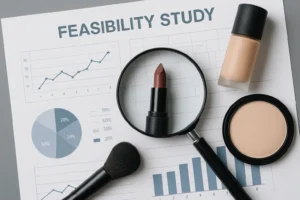
How Much Does It Cost To Create A Beauty Brand?
The goal here is to make the estimated cost of your cosmetics project quantifiable for your specific city. To do so, follow these steps:
1) Divide Costs into Categories
- Store Location and Fixtures: Rent, décor, shelving, lighting, Point of Sale (POS) system.
- Opening Inventory: Essential makeup + skincare + 30–50 ml fragrances and mini perfumes.
- Operations and Logistics: Packaging materials, shipping supplies, invoicing, and the digital store platform.
- Marketing and Content: Photography, samples, and launch promotional offers.
As a comfortable starting rule: place the greatest proportional weight on fast-moving inventory, then on only necessary fixtures, and launch the online channel from day one to mitigate risk.
2) How to Determine Budget Percentages?
- Opening Inventory: 45–55% of the total budget.
- Fixtures and Store Setup: 20–25%.
- Marketing and Content: 8–12%.
- Operations and Reserve for the first 2–3 months: 12–20%.
These percentages are flexible and vary depending on the city and location. The objective is to set a logical cap for each item and monitor deviations monthly.
3) The Smart Product Mix
- Makeup Project: Focus on practical foundation shades, mascara, neutral lipstick, and eyeliner—products with a rapid repurchase cycle.
- Fragrances with Cosmetics: 30–50 ml sizes for a primary purchase decision, and mini perfumes as a bundling item to boost the basket size.
- Cosmetic Tools: Brushes, sponges, and makeup remover to increase the item-per-invoice rate.
As a perfume and home fragrance manufacturer, we provide a publicly tested selection of scents that help you control costs without freezing capital in slow-moving items. Request a sample pack and bottling options: Contact us via WhatsApp.
Profitability of a Cosmetics Business
We provide here a framework for calculation that you can adapt locally, The goal is for you to visualize the profit picture of a cosmetics store based on your realistic inputs.
1) Standard Cost Model
- Monthly Sales: Average Basket Size × Daily Transactions ×30.
- Gross Profit: Sales × Blended Gross Margin (Skin + Makeup + Fragrance).
- Net Operating Income: Gross Profit − Fixed/Variable Expenses.
- Break-even Point: Fixed Expenses ÷ (Average Basket Size × Gross Margin).
The Gross Margin is influenced by your product mix: the greater the share of high-margin Skincare and Makeup, combined with fragrances as a bundling item, the better the Net Profit. Recent reports confirm that beauty continues its growth through 2030, with fragrances specifically being a key category driver, with a market estimated at approximately $56.6 billion in 2024 and an annual growth rate of about 4.9% through 2030.
2) Why is mixing fragrances a good idea?
- Increased Average Basket Size: “Daily Makeup + Mini Fragrance” bundles drive the purchase decision.
- Repeat Purchase: Favorite scents bring customers back for repeat experiences and replenishment.
- Private Label Story: Gives you flexible pricing and competitive differentiation on the shelf.
How to create actionable steps?
- Develop a short, fast-moving opening list for makeup and skincare.
- Add mini perfumes by Jasmine as an essential bundling item.
- Launch a WhatsApp ordering channel and a simple e-commerce store, and run seasonal promotions.
- Monitor track your Average Basket Size, Transaction Count, and the percentage of fragrances in each invoice and adjust the mix monthly.
Ask the Jasmine team for a sample pack of publicly tested scents and a suggested size breakdown (30–50 ml + Mini) that suits your city and target audience. Contact us via WhatsApp.
Also read: Opening Perfume Store: Requirements, Costs, & Profits
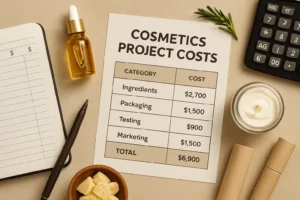
Can You Sell Cosmetics and Fragrances Online?
Selling makeup and fragrances online is both possible and worthwhile when the experience is built around what truly matters to the customer: quick discovery, authentic images, and an instant ordering process.
Recent data strongly encourage you to move forward:
- McKinsey’s 2025 reports predict that the digital channel’s share of global beauty sales will approach one-third by 2030, up from 26% in 2024. This means launching an online cosmetics business is no longer a peripheral option but a major growth channel alongside a traditional store, if one exists.
- Along the same lines, NIQ data shows that online beauty sales grew nine times faster than in-store sales over the past year, with double-digit digital growth across Europe, Asia, and North America—a clear indication that consumers are now comfortable with digital purchases in the beauty category when the experience is seamless and clear.
At Jasmine, we provide publicly tested scents in packages suitable for e-commerce, offering private labeling and flexible bottling for mini/30/50 ml sizes. This allows you to easily create “Makeup + Fragrance” bundles with clear visual differentiation on your page, which is precisely what any cosmetic tools project needs to increase conversions without significantly escalating costs.
Ready to prepare a practical starter pack for your fragrance products? Message the Jasmine team to suggest an assortment of sizes, professional product photos, and ready-to-use description cards for your store: Contact us via WhatsApp. You can also explore our manufacturing, bottling, and private label solutions on our website.
Also read: Online Perfume Trade: Top Strategies to Boost Your Sales
Key Tips for a Successful Cosmetics and Fragrance Business
- Narrow your initial offering to fast-moving daily makeup (common foundation shades, mascara, neutral lipstick) + essential skincare + mini/30/50 ml fragrances. This reduces complexity and accelerates inventory turnover.
- Offer “Daily Makeup + Mini Perfume” or “Evening Makeup + 30 ml” bundles, including an upgrade voucher for a larger size. (Key phrase: Integrating Fragrances with Cosmetics)
- Secure your supply chain with a reliable manufacturer. At Jasmine, we provide publicly tested fragrances and private label options in flexible sizes, serving your cosmetics and fragrance project while reducing returns.
- Launch only 20–40 products, monitor the top sellers for 4 weeks, then increase the depth (shades/sizes) rather than increasing the horizontal breadth of your selection.
- Divide products by routine (cleanse/moisturize/protect) and by occasion (work/evening/gift) with clear price tags.
- Set a makeup trial area + a fragrance tester cabinet. Testing boosts conversion and reduces purchase hesitation.
- Use photos on diverse skin tones, and offer a three-point description: “What does it do? Who is it for? How is it used?”
- Publish Short, Selling Content by creating 15–30 second “Before/After” and “Shade Selection” videos, with an immediate link to purchase. Avoid overspending on major influencers; start with local micro-influencers and swap part of the fee for samples and gift bundles.
- Implement Simple Offers that Don’t Hurt Margins as a free mini fragrance above a specific purchase threshold, or a discount on the second item from your cosmetic tools project (brushes/sponges).
- Monitor competitor pricing, make bundles more prominent than direct discounts, and maintain uniform pricing between the physical store and online.
- Track Key Health Indicators Weekly: Average Basket Size, Transaction Count, Fragrance Ratio per invoice, Top-Selling Products, and Return Rate. Adjust your offering based on data—not impression.
- Reorder fast-moving products early, and minimize stocking depth for slow-moving colors. Use the first few weeks’ data to inform subsequent purchasing decisions.
- State the delivery time and cost before checkout, and prepare packaging that protects the fragrances and encourages unboxing and sharing.
- Build Post-Sale Service to Enhance Loyalty by posting a a short survey via WhatsApp after delivery + a purchase voucher for the next visit. Collect customer feedback on product pages as social proof.
- Plan offers for Ramadan/Holidays/Winter/Back-to-School. Update scents and bundles according to the season and mention limited quantities to create gentle scarcity.
- Ensure Compliance with Labels and Health Regulations by completing product data and labeling in your local language builds trust and reduces legal risks.
- Craft a Private Label Story to Differentiate Quickly and create a direct competitive advantage to boost the cosmetics store’s profits.
- Start Online Even with a Physical Store by building a simple landing page + WhatsApp catalog is enough for launch. Add a full e-commerce store later. This lowers the initial cosmetics project cost and increases reach.
- Test, Measure, Repeat Every week and scale what succeeded.
Ready to turn these tips into an action plan? Contact us via WhatsApp and ask the Jasmine team for a sample pack of tested scents, along with suggested mini/30/50 ml sizes and ready-to-display bundles for your physical and online store.
Also read: Create Perfume Brand From Scratch for Your Store
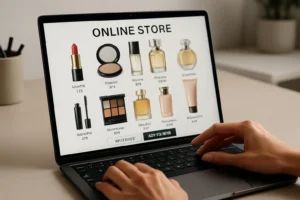
Why is Jasmine One of the Best Perfume and Home Fragrance Manufacturers in Turkey?
Because we focus on what truly matters to you as a retailer or an entrepreneur in the cosmetics and fragrance industry: consistent quality, quantity flexibility, and the ease of launching a brand that sells from day one. At Jasmine Factory, we build our partner relationships on clear pillars:
- Publicly Tested Scents: Our labs create and blend “guaranteed-acceptance” fragrances that suit both Arabic and Turkish tastes, with precise customization options to give your brand a unique olfactory identity.
- Custom Product Manufacturing Service: Private label bottling (bottles, caps, labels, and cartons) with ready-made design templates. This significantly cuts time-to-market and simplifies the launch of an online cosmetics business or the expansion of an existing makeup retail project.
- Flexible Quantities and Tiered Pricing: From mini perfumes for market testing to 30/50 ml sizes for daily sellers, this preserves liquidity and minimizes waste—a critical factor in boosting cosmetics store profits.
- Stable Supply Chain and Reliable Schedules: Selected raw materials, quality checks on every batch, and precise filling that ensures consistency between orders—a vital point when you scale rapidly.
- Launch and Marketing Support: Professional product photography, concise description copy (“What it does/Who it’s for/How to use it”), and bundle ideas that link fragrance with makeup and the cosmetic tools project.
- Direct and Fast Communication: A consulting team that understands your needs and responds to changes in scents and packaging efficiently—making it easier for you to execute your cosmetics business feasibility study and confidently define your initial assortment.
Learn about our manufacturing, private label bottling solutions, and our own brands by visiting our website, or for immediate practical discussion, contact us now via WhatsApp.
How to Integrate Fragrances with Cosmetics to Increase Profits?
- Start with a Low-Risk Entry Point: Offer an exploratory list of 4–6 scents (mini sizes), with an upgrade voucher for a 30/50 ml bottle.
- Design Bundles that Link Function to Olfactory Moment: “Morning Skincare Routine + Refreshing Mini Fragrance,” “Evening Makeup Look + Warm Fragrance.” When the message is functional and clear, the average basket jumps without pressure to offer discounts.
- Make Fragrance a Natural Upsell at Checkout (In-Store and Online): When foundation/mascara is added to the cart, automatically suggest a mini perfume at an incentivized price. Consistent, light-touch linking is more effective than a short-lived, major discount campaign.
- Tier Fragrances in No More Than Three Sizes: Mini for discovery, 30 ml for adoption, 50 ml for loyalty. Limited segmentation keeps the decision quick and prevents inventory scatter—helpful when building a makeup retail project with a smart fragrance addition.
- Build “Scent Stories” Instead of Just Names: Describe the feeling and use: “Morning fresh after sunscreen,” “Warm for evening outings.” The story brings the fragrance closer to the makeup routine.
- Use a Smart Seasonal Plan that Doesn’t Overwhelm Inventory: Launch only two seasonal scents per quarter with a matching makeup bundle (colors/look). Fewer releases imply “desirable scarcity” and simpler inventory planning.
- Photograph on Diverse Skin Tones: When a customer sees the lipstick shade and the fragrance effect as part of a complete look, combining the two categories becomes intuitive and visually serves the cosmetics and fragrance project.
- Calculated Discounts… and More Generous Bundles: Instead of cutting the price of a single fragrance, offer “Makeup + Free Mini Fragrance” above a certain purchase limit. Small gifts build loyalty and protect your margin.
- Use WhatsApp as a Short Purchase Path: Keep the “Order Now via WhatsApp” button constantly visible; send scent suggestions based on the makeup in the cart, and include a quick photo of the bundles. This is the fastest channel for daily beauty decisions.
- Weekly Measurement Guides Decisions: Monitor the fragrance ratio per invoice, the most frequently bundled products, and scent preferences by time/season. Move what works to the forefront, and reduce what doesn’t move.
Ready to transform these tips into an action plan? Contact us via WhatsApp and ask the Jasmine team for a sample pack of tested scents, with suggested mini/30/50 ml sizes and bundles ready for display in your physical and online store.
Also read: Perfume Factories in Istanbul: Your Guide for the Best Manufacturer
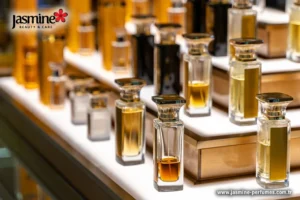
FAQs About Starting a Cosmetics Business
Is cosmetics Profirtable business?
It is highly-profitable because it relies on repeat consumption and a basket size that is easily increased by bundling makeup and fragrances. The more you focus your initial assortment on fast-moving products (foundation, mascara, lipstick) with a mini fragrance as a gift or an upsell, the higher your cosmetics store profits will be without resorting to heavy discounts. Start with a simple plan, then scale based on actual sales, and you will quickly see the positive effect on cash flow.
How profitable are cosmetics?
It is medium to high and significantly improves with three factors: a smart product mix, lean inventory management, and an active digital channel. If a small physical store is combined with an online cosmetics business via WhatsApp/e-commerce, risk is distributed and the purchase frequency increases. Choosing a consistent quality supplier like Jasmine for fragrances helps stabilize margins and reduce returns.
Is cosmetic business profitable?
It is profitable when managed with focus, not random expansion. Treat the cosmetic tools project as a profit driver (brushes, sponges, makeup removers) and integrate them with “buy-one-get-one” offers to increase the average basket size. Link every invoice with a small fragrance suggestion; this simple trick alone makes a difference in your monthly net profit.
How do I start my own cosmetic business?
Define your segment and location, then prepare a concise cosmetics business feasibility study (assortment, pricing, sales channels). Set up a clear display and a testing corner, and open an instant ordering channel via WhatsApp. Launch with a list of Top SKUs + mini perfumes, and start weekly measurement (top sellers, average basket, returns) to inform subsequent purchasing decisions. For your own brand fragrances, source them via Private Label from Jasmine.
How do I start my own skincare business?
Start with an essential three-step routine: Cleanse, Moisturize, and Protect (SPF), using travel-friendly sizes initially to lower the cosmetics project cost. Offer bundles like a “Morning Routine + Refreshing Mini Fragrance” and “Evening Routine + Warm Fragrance” to increase basket value. Ensure you have “Before/After” photos and simplified descriptions (What does it do? Who is it for? How is it used?) and build trust with customer reviews.
Are natural beauty products worth it?
It is profitable provided there is clarity and compliance. Focus on common solutions (moisturizer, Vitamin C serum, sunscreen) and offer them in gift bundles with a naturally inspired fragrance from Jasmine to distinguish the brand. Success in this segment relies more on storytelling and product transparency than on lowering prices.
Supporting Modern Sources
- McKinsey – State of Beauty 2025: Forecasts an annual growth of nearly 5% through 2030, with the market reaching ≈$590 billion by 2030.
- NIQ 2025: Significant global beauty growth over the last 12 months, with online sales growing much faster than in-store sales.
- Grand View Research: The global perfume market is ≈$56.6 billion (2024) with an expected CAGR of 4.9% through 2030; the luxury fragrance segment is also showing strong growth.
- Corporate Performance Reports: Continued fragrance momentum in the results of major global companies throughout 2024–2025.